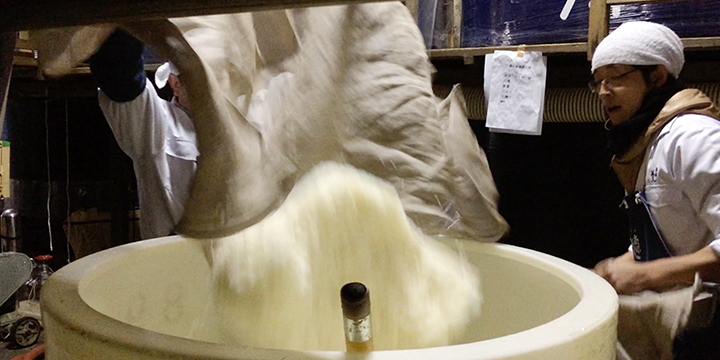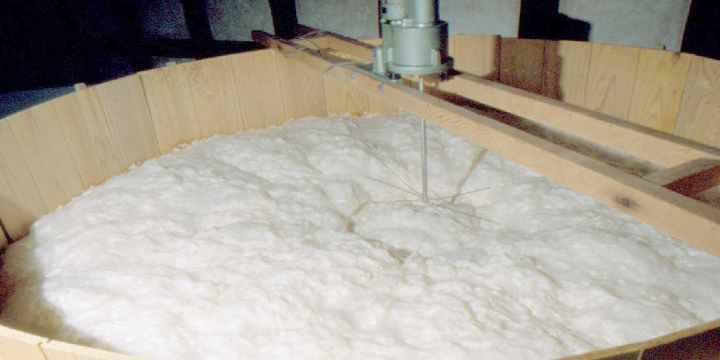Particular About Moromi (Fermentation mash)
3 step preparation.
After koji and fermentation starter are ready, it is time for the preparation of fermentation mash
The preparation of fermentation mash of sake requires three-step.
Usually, to prepare the fermentation mash of sake, koji , sake rice except for koji making and water are put into the tank.
First step is called, Soe , first addition
Second step is called Naka, second addition, middle addition
Final step is called Tome, third addition, final addition
The amount of rice is gradually increased for this three step preparation.

For example. Total amount of preparation is 700 kg, it includes as follows;
Soe , first addition
Rice for making Koji, 35kg
Sake rice except for Koji making 85kg
Water for sake making 147l
Naka, second addition, middle addition
Rice for making Koji, 45kg
Sake rice except for Koji making 195kg
Water for sake making 313 liters
Tome, final addition
Rice for making Koji, 48kg
Sake rice except for Koji making 242kg
Water for sake making 242 liters
The preparation temperature needs to keep about 13 degrees for Soe , first addition,
About 8 degrees for Naka, second addition
About 6 degrees for Tome, third addition
It will set up gradually with lowering the temperature.
It will take about 7 to 10 days to reach the highest temperature, from 10 to 13 degrees, after tome stage.
Now, you might understand that Japanese sake is required to prepare in cold winter only, because it need to be fermented under the cold condition.
The highest temperature is about 10 degrees for
DaiGinjo, super premium Ginjo made from highly-polished rice
But the temperature is about 12 to 13 degrees for;
Junmai, pure-rice sake, made only from rice and rice Koji (without addition of brewers alcohol)
Or
Honjozo-Shu made from quality rice with addition of limited volume of brewers alcohol
We think it is best to maximize the taste of the rice to sake making.
DaiGinjo is fermented in one of the limit of life or about to dead for the yeast, so it turned out to have a fruity aroma.
The bubble of fermentation mash, is pushed out on 5th to 7th day in its peak and it will disappear in fermentation mash, Tamaawa becomes the smallest and, then, disappears on 12th day.
The status without bubble is called “Ji”.
All we have to do is only one stir in the morning.
It would spill from the tank and foams come out of the tank, we have to put the shade on the tank not to spread the foams
We use the anti-foam machine to hold the foams to come up.
Now, the yeast without foams can be used recently, however, our sake brewery workers are so young that they do not have much experience.
We use the yeast with foams in order to judge the status of fermentation mash, not only by the outlook but also by the status of foams.
To tell the truth, it requires much effort to prepare for the shade for foams, it has become obsolete gradually to use the yeast with foams.

After 15th day from Tome, third addition, fermentation will have progressed so we need to cool down the temperature little by little.
Cold water through on the mat covered around the tank is a way to cool down the temperature of the fermentation mash.
It will take 7 days to cool down the temperature from 10 degrees to 6 degrees to hold the progress of mush fermentation.
During the 30 days of fermentation period, for DaiGinjo ,we take a small amount of fermentation mash each day, and analyse the sake degree, acidity, amino acid level, and alcohol,
For Junmai and Honjozo, we take one fermentation mash every two days and analyse.
In this long tasks, it takes almost 30 days to make Japanese sake.
We want to draw the original rice flavor and aroma by cold and long fermentation.
Now, finish the fermentation process, we will go to next step, compressing or squeezing.



